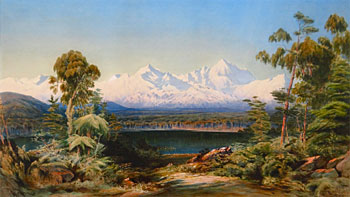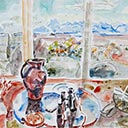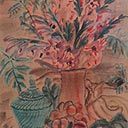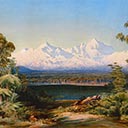Mt Tasman and Mt Cook
73 x 130 cm
est. $50,000 - 70,000
Provenance:
Private Collection, Wellington
Gully immigrated to New Zealand from Bath in 1852 accompanied by his wife Jane and their three children. The family settled in Omata, Taranaki where they purchased the Omata Store in 1854. Sadly, lack of trade resulted in bankruptcy and the family's relocated to New Plymouth. Gully advertised his availability to paint views of properties for sending abroad and served as a volunteer during the Land Wars. He was invalided out of the army as the conditions were too severe for his constitution. In 1860 the Gully family left New Plymouth for the city of Nelson, purchasing a house in Trafalgar Street with a large orchard and garden. It was here that the artist spent the rest of his life. Gully was encouraged by the geologist Julius von Haast, who commissioned twelve watercolours of the mountains and glaciers of Canterbury. These watercolours were used to illustrate a lecture given by Haast at the Royal Geographical Society in London in 1864.
Gully became part-time drawing master at Nelson College. Later, through the assistance of politician and artist James Crowe Richmond, he was appointed full time draughtsman to the Nelson provincial survey office. During his lifetime Gully enjoyed popularity and success as an artist, today he is regarded as one of New Zealand's foremost landscape painters. Working almost entirely in watercolour, Gully's field trips yielded a legacy of many finely worked sketch-books full of careful pencil studies and numerous quick-wash drawings both in colour and sepia. Large scale watercolours such as the present lot, became immensely popular as centre-pieces at art society shows. Today only a few such works remain in private hands. Gully enjoyed recognition and success in his life time. All of Gully's watercolours submitted to the 1865 New Zealand Exhibition in Dunedin sold prior to the exhibition opening. He exhibited at the British Royal Academy in 1871. In 1873, nine paintings we sent to the New Zealand court at the International Industrial Exhibition in Vienna. In 1886 he exhibited at the India & Colonial Exhibition in London and the Intercolonial Exhibition in Melbourne. He also exhibited works with the Society of British Watercolour Artists in London. Gully Died in 1888 aged sixty nine.





